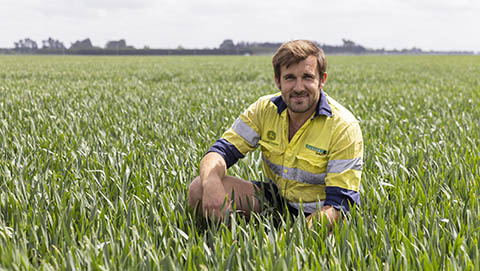Last year, Cust farmer Roscoe Taggart was one of two New Zealand farmers selected to trial a Yara N sensor on his family’s 730 hectare arable and sheep farm. He saved a significant amount of nitrogen fertiliser and plans to quantify the environmental and economic benefits of using the sensors during the current season.
Roscoe is participating in a project which examines how the next generation of farmers are using innovation to improve their farming practices. Waimakariri Landcare Trust (WLT) and Waimakariri Irrigation Limited (WIL) have partnered with the Ministry for Primary Industries (MPI) for the project, with support from MPI’s Sustainable Food and Fibre Futures fund along with Environment Canterbury, Ballance, and DairyNZ.
With a less than ideal harvest season last year due to inclement weather, Roscoe is hoping a more normal weather pattern this year will provide him with the data to show that the N sensor is having a positive impact on his farming operation.
“Due to the heavy rain last year, we couldn’t truth our findings, but we did use significantly less fertiliser and we got comparable yields to other farmers.
“Hopefully, this season will be the determining one in terms of getting solid data. With the cost of diesel and fertiliser skyrocketing and interest rates going up too, everywhere that you can save while being more efficient on your farm is a bonus.”
The N-sensor is fitted to the roof of Roscoe’s tractor and allows him to measure the precise amount of nitrogen required for each area of crops in a paddock. As the fertiliser spreader moves through the paddock it varies the fertiliser application rate according to the data that the N-sensor receives.
The amount of nitrogen is determined by measuring the crop’s light reflectance. Measurements are taken every second at specific wave bands which reflect the crop’s biomass and chlorophyll content. The system then calculates the crop’s nitrogen uptake which enables the correct amount of fertiliser to be applied directly to the plant.
Roscoe says that while the technology used by the N-sensor is complex, the actual operation couldn’t be any easier.
“It is extremely easy to use. You just hop in the tractor and the sensor does all the work for you. It is all algorithm-based and we don’t need to have any further input from our end.
“That’s the key to anything like this really. It must be simple or else it will be put in the too hard basket.”
Roscoe views precision agriculture as a way of contributing to the legacy of his family’s farm which has been handed down over three generations.
“I got into precision agriculture as a way of making my mark on the farm. Grandad bought the farm; Dad irrigated the farm and for me it was precision agriculture that caught my attention.
“Technology is allowing us to try new ways of farming that previous generations haven’t had the opportunity to do. The way technology is moving if we give it five years, I think it will be a whole different picture in terms of how we are using it to solve all sorts of farming challenges.”

Cust farmer Roscoe Taggart hopes to prove the benefits of using sensor-based nitrogen application on his farm as part of his drive to use more precision agriculture technology in his operation.